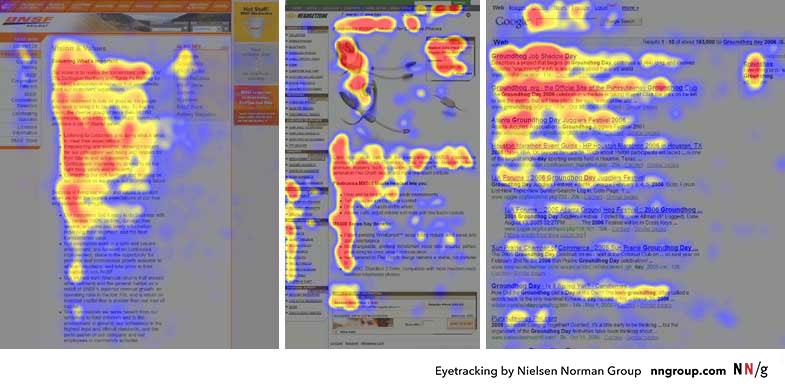
What is an F Format Resume?
The F format is an offbeat, data-backed template created to highlight and focus on your professional skills and competencies, while relegating lesser importance to your work experience.
It groups the tasks you’ve performed in all your roles under different skills which serve as the header, rather than the organization they were executed in; in simple terms, skills replace the organization, role & tenure, and the work is categorized accordingly.
Why was this format created & why is it used?
According to an old study by the Nielsen Norman group in 2006, when scanning text (reading really quickly), people follow an ‘F’ pattern, as demonstrated below:
Essentially, people read from left to right and top to bottom, in that order, resulting in a visual heatmap similar to the one above. It meant that:
- The first few words in a sentence are read more than the remainder
- The first few lines and sentences have a much higher chance of being read and paid attention to, than those the end of the article
Thus, resume writers inferred, it made more sense to include your skills and competencies first, as they’re more relevant than the organizations one has worked in, after all.
What they failed to account for, unfortunately, is that this article was published solely for poorly designed web-based content on computers, especially for viewers that weren’t fully engaged due to disinterest or paucity of time.
Technically, these traits apply to recruiters - they’ll most likely be viewing your resume on a screen, and they certainly face a shortage of time; what they seem to have ignored is the operative phrase ‘poorly designed’, by which the NN Group meant:
- A wall of text, with
- No headers, subheaders or other forms of categorization or differentiation in the text
- No bullet points or text formatting like italics or bold to draw your attention
Unless you’re utterly uninitiated to the art of resume writing, you’d know none of the three apply to resumes.
Furthermore, this F-pattern is not a universal, species-wide trait - in many Arabian and South-east Asian countries, their script is read right to left or even top to bottom! Additionally, this is not the only reading/scanning pattern observed!
In fact, the NN group themselves researched & published a second article that clearly mentions the fallacy of applying this research to content, and in some cases. even using it as the basis for the same!
They identified and mentioned several other reading patterns such as the layer-cake pattern, spotted pattern & marking pattern among others.
While the NN Group's aim was to incentivize content optimization to prevent this pattern from emerging, this was completely misunderstood and taken as some ironclad tenet to design content around. Sounds reminiscent of Tomorrowland’s premise around the apocalypse!
When is this format used?
If it has not been clear enough, the premise for this format is erroneous. It is not to be used unless specifically asked for.
That said, it is useful in three scenarios:
- If you have long periods of employment gaps
- If you want to work in an entirely new industry
- If for some reason you need to showcase your professional skills first and your work experience later on
In all three cases it could help to showcase your professional skills and prioritise them over your work experience; at least that was the reasoning for this resume format. However there are resume templates that can provide this benefit without resorting to this poor format, which we shall get to in a moment
Why you should never use this format
While this format makes sense from a user point of view; for recruiters it is a complete waste of time; indeed, they are known to hate it.
Traditional formats where your work experience is in a reverse chronological order help recruiters to track your career trajectory - they see your professional growth and development in the skill sets that you possess as well as the growth in your professional responsibilities.
This is vital to understanding your fit for both the company, as well as the position that you are applying - to something that a functional resume does not help with.
Furthermore, recruiters are used to scanning particular sections of a resume based on their experience, and a completely different resume format could leave them stumped and they may or may not focus on the relevant parts of the resume, or even confine it to the rejection pile.
What is the alternative?
So you must be wondering if you belong to any of the three scenarios presented above what should you do? The answer is simple - you prescribe to a hybrid resume format which combines the best of both worlds.
These are currently the industry standard as they provide:
- The relevant skills that you possess
- A snapshot of your entire profile based on a very comprehensive but crisp professional summary, and
- Your work ex in the reverse chronological order showing your career trajectory from start to present
MakeMyResume is among many of the world's leading professional resume writing services that subscribes to this template, unless a Visual or International resume format is required.
TL;DR - An F format resume is a resume template based on the fallacious interpretation of a study by the Nielsen Norman group which stated that people tend to read web content in an ‘F’ pattern, i.e. the first few words of every sentence and the first few lines of every page garner the maximum attention and the rest would not, resulting in an F-pattern. In this template professional skills are listed as headers instead of the organisation you worked for and your tenure in them, and your responsibilities are grouped accordingly.
Due to various reasons including the failure to track your career trajectory, recruiters despise this format and it is strictly recommended to not use it unless specifically asked to. What you can do instead Is adhere to a hybrid resume format which companies like MakeMyResume use.




